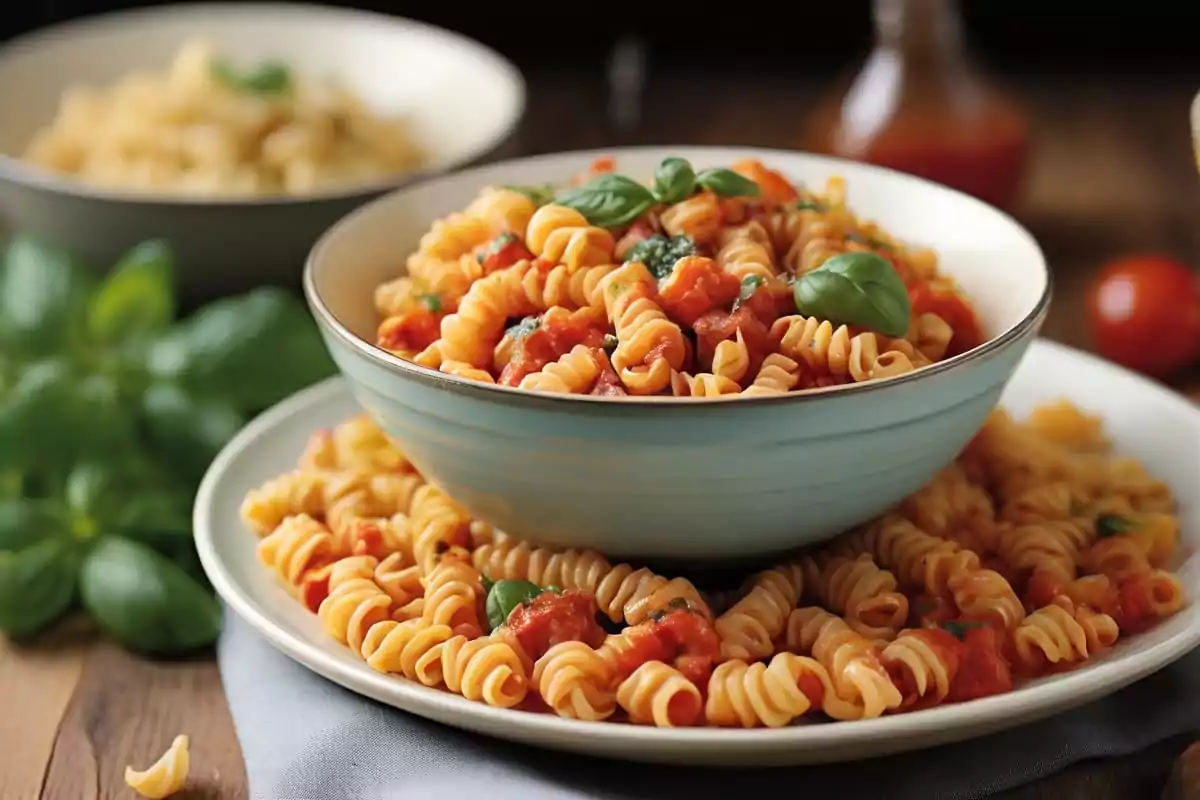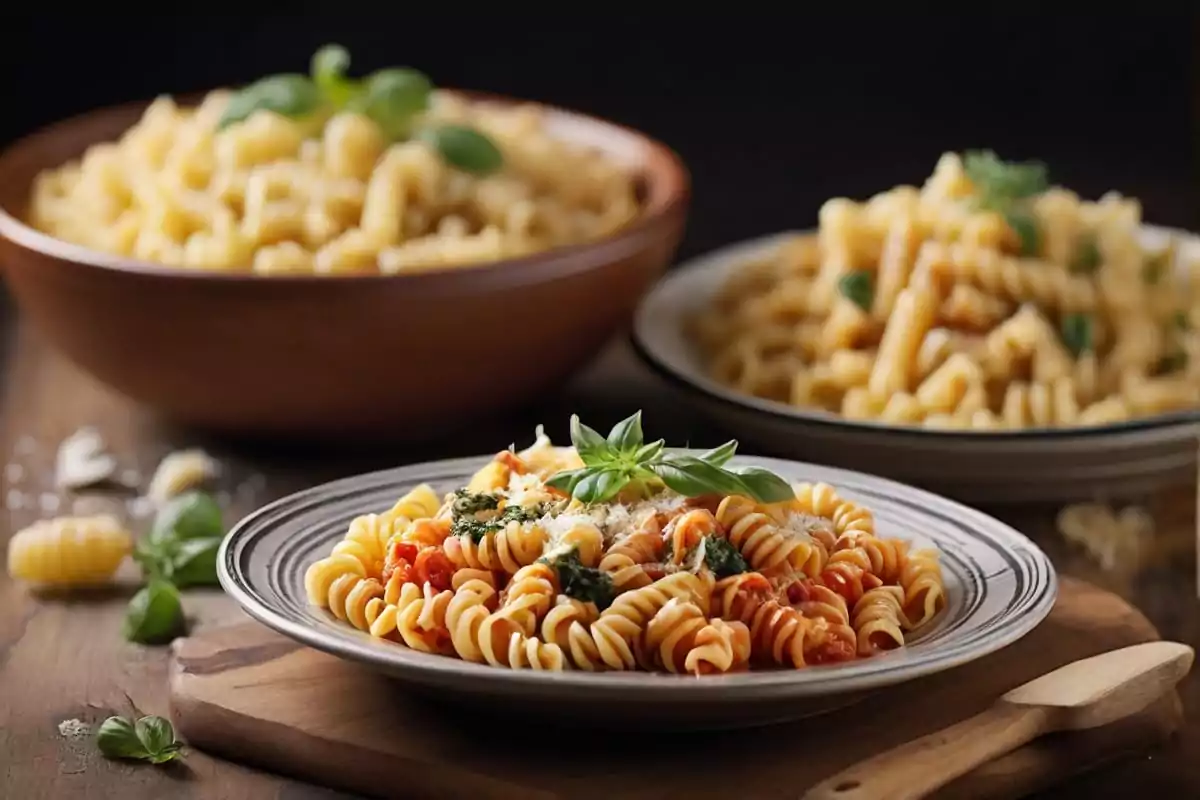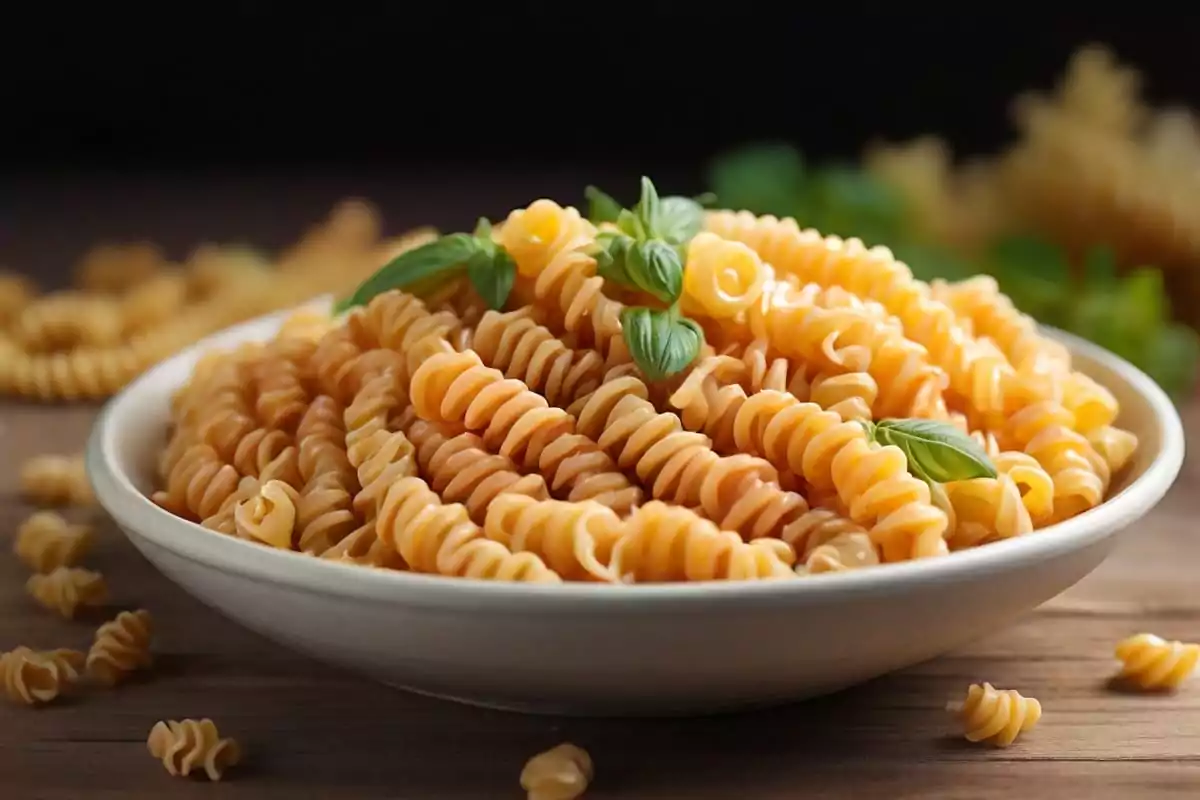Introduction to Pasta Varieties
Pasta, with its myriad forms, stands as a pillar of Italian cuisine, showcasing the diversity of culinary traditions that have transcended Italy’s borders. Among the plethora, fusilli and rotini capture our interest. Yet, before diving into these two, let’s appreciate the broad spectrum of pasta shapes gracing our tables.
Each pasta shape serves a purpose, marrying form and function to suit specific sauces and methods. From spaghetti’s slender elegance to rigatoni’s robust ridges, the pasta shape enhances a dish’s texture and flavor. Thus, choosing pasta is as crucial as selecting the sauce.
Understanding pasta shapes is like mastering a language, unlocking a world of culinary possibilities. Whether twirling spaghetti or scooping minestrone with ditalini, pasta shape significantly impacts the dining experience. It’s a blend of texture, flavor, and tradition, where each shape narrates a story of regional origins and artisanal craftsmanship.
As we delve into fusilli and rotini, remember pasta’s rich diversity. Our journey through history, culture, and flavor reveals insights into one of the world’s most cherished foods. So, let’s dive in, unraveling the mysteries of fusilli and rotini, to discover their unique places in the vast, delicious world of pasta.
For those eager to explore more about the intricacies of pasta shapes and their culinary applications, our Fusilli Pasta Guide offers a deep dive into the world of fusilli, providing readers with everything from basic knowledge to innovative recipes that will inspire your next pasta dish. This guide is an invaluable resource for anyone looking to enhance their understanding and appreciation of fusilli, a pasta shape that embodies the spirit of Italian cooking and tradition.

Fusilli and Rotini Defined
What is Fusilli Pasta?
Fusilli, a twist of culinary artistry, originates from the sun-drenched regions of Southern Italy. Its name, derived from ‘fuso’, hints at its spindle-like shape, a nod to the traditional method of rolling dough around a rod. This process, once a simple artisanal craft, has evolved, yet the essence of fusilli remains rooted in its helical allure.
Origin and History
In the tapestry of Italian pasta, fusilli holds a colorful thread, tracing back to humble beginnings where hands and spindles danced together to create spirals of dough. This pasta, with its origins steeped in tradition, embodies the ingenuity of Italian cooks, transforming simple ingredients into culinary masterpieces.
Characteristics and Uses
Characterized by its curly spirals, fusilli is more than just a shape; it’s a vessel for sauces, its grooves and twists eagerly embracing thick, hearty concoctions. Whether it’s a robust tomato sauce or a delicate cream, fusilli ensures every bite is flavorful, making it a versatile player in the pasta world.
Variants of Fusilli
Beyond the classic spiral, fusilli diversifies into fusilli bucati, with hollow centers, and fusilli lunghi, resembling the length of spaghetti. These variants not only add visual interest but also offer different textures and sauce-holding capabilities, showcasing the adaptability of fusilli.
How to Make Fusilli at Home
For the adventurous home chef, making fusilli is a foray into the art of pasta making. With just flour, eggs, and a pasta press, one can transform simple ingredients into spirals of joy. The process, a blend of tradition and technique, invites you to bring a piece of Italy into your kitchen.
What is Rotini?
Rotini, often mistaken for its curly cousin, boasts its own unique charm. Originating from Northern Italy, its name, meaning ‘small wheels’, reflects its spiral extrusions that resemble miniature corkscrews. This shape, while similar to fusilli, has its distinct identity and culinary role.
Origin and History
Rotini emerges from the rich tapestry of Northern Italian pasta traditions, a testament to the region’s innovation in pasta design. Its creation, aimed at capturing every drop of sauce, speaks to the Italian dedication to culinary perfection.
Characteristics and Uses
With tighter spirals than fusilli, rotini is a master at holding sauces and small ingredients, making it ideal for salads and light, creamy sauces. Its design ensures that each forkful is a harmonious blend of pasta, sauce, and additions, offering a delightful texture and flavor experience.
Preparing Rotini from Scratch
Though less common than buying it ready-made, crafting rotini at home is a rewarding endeavor. Adjusting the dough’s thickness and spiral tightness allows for a personalized pasta experience, inviting creativity into the cooking process.
As we explore the nuances of fusilli and rotini, it becomes clear that while they share similarities, their differences are profound. Each brings its unique qualities to the table, enriching our culinary adventures with their distinctive shapes and textures. Whether you choose fusilli for its sauce-cradling capabilities or rotini for its delightful bite in salads, both pastas offer a world of flavor and tradition, waiting to be explored.
Comparing Fusilli and Rotini
The journey through the pasta universe brings us to a pivotal question: how do fusilli and rotini stand apart, and when might one choose one over the other? While they twirl on our forks with similar grace, their distinctions lie in the details.
Key Differences Between Fusilli and Rotini
Shape and Texture
At first glance, fusilli and rotini might appear as two peas in a pasta pod. However, fusilli boasts larger, more open spirals, akin to a spring in full bounce. This structure makes it a haven for thicker, chunkier sauces, allowing them to cling with gusto. On the flip side, rotini, with its tighter spirals and more compact form, excels at trapping lighter, more delicate sauces, ensuring each twist is evenly coated.
The texture also plays a significant role in their culinary applications. Fusilli, with its robust spirals, provides a hearty bite, perfect for dishes that demand a pasta with presence. Rotini, meanwhile, offers a slightly more delicate chew, making it a favorite for pasta salads where it mingles with dressing and ingredients seamlessly.

Culinary Uses and Sauce Pairings
When it comes to the kitchen dance of pasta and sauce, fusilli and rotini each have their preferred partners. Fusilli, with its ability to embrace and hold onto sauces, shines in dishes where the sauce is the star. Think rich tomato meat sauces or creamy Alfredo, where its spirals can capture every nuance of flavor.
Rotini, with its tighter coils, is a champion of lighter, more fluid sauces. It’s the pasta of choice for vinaigrette-tossed pasta salads or dishes where a delicate pesto needs to be evenly distributed. Its structure ensures that every nook and cranny holds a hint of the sauce, delivering consistent flavor in every bite.
In essence, while both fusilli and rotini can be used in a wide array of dishes, their unique shapes and textures lend themselves to different types of sauces and culinary contexts. Whether you’re in the mood for a hearty, sauce-heavy meal or a light, refreshing pasta salad, choosing between fusilli and rotini can elevate your dish from good to unforgettable.
As we navigate the twists and turns of these pasta varieties, it becomes evident that the choice between fusilli and rotini isn’t just about shape—it’s about the interplay of texture, sauce, and the culinary experience you wish to create. So next time you’re pondering which pasta to bring to the boil, consider not just the sauce you’ll use, but the texture and bite you desire. Whether it’s the open arms of fusilli or the tight embrace of rotini, each brings its own charm to the table, making our culinary adventures all the more delightful.
Cooking Techniques and Recipes
Mastering the art of cooking fusilli and rotini is a gateway to a world of delicious, versatile pasta dishes. Each type of pasta, with its unique shape and texture, pairs beautifully with specific sauces and ingredients. Here, we’ll dive into how to cook these pastas to perfection and explore some mouthwatering recipes that showcase their versatility.
How to Cook Fusilli and Rotini Perfectly
Cooking Fusilli
To bring out the best in fusilli, start with a large pot of salted boiling water. Adding the pasta to boiling water is crucial for preventing sticking and ensuring an even cook. Stir occasionally in the first few minutes to keep the spirals from clumping together. For fusilli, the ideal cooking time usually ranges between 11 to 13 minutes, aiming for an al dente texture. This means the pasta should be tender yet firm to the bite. Once cooked, drain the fusilli and toss it with your sauce of choice immediately to prevent it from sticking.
Cooking Rotini
Rotini, similar to fusilli, requires plenty of boiling, salted water. The key difference in cooking rotini lies in its slightly shorter cooking time, due to its tighter spirals and thinner structure. Typically, rotini cooks in about 7 to 9 minutes. Keep an eye on the texture, and taste test a piece to ensure it’s al dente. After draining, mix the rotini with your chosen sauce or dressing while it’s still warm to maximize flavor absorption.
Delicious Recipes Featuring Fusilli and Rotini
Fusilli Pasta Recipes
- Healthy Red Hot Fusilli: This vibrant dish combines fusilli with a spicy tomato sauce, fresh basil, and Parmesan cheese. The spirals of fusilli catch every bit of the sauce, delivering a kick of heat with every bite. Find the recipe here.
- Broccoli and Roasted Garlic Pasta: A testament to fusilli’s versatility, this recipe blends roasted garlic and tender broccoli with whole wheat fusilli, creating a dish that’s both flavorful and nutritious. Check out the recipe.
Rotini Pasta Recipes
- Rotini Chicken Casserole: Perfect for a comforting meal, this casserole layers rotini with chicken, mushrooms, and a creamy sauce, topped with breadcrumbs for a crispy finish. Get the recipe here.
- Italian Vegetable Rotini Alfredo: Light yet satisfying, this dish showcases rotini’s ability to pair with a creamy Alfredo sauce and a bounty of seasonal vegetables. Find the full recipe.
Cooking fusilli and rotini to perfection and pairing them with the right sauces and ingredients can transform a simple pasta dish into a culinary masterpiece. Whether you’re in the mood for something spicy, comforting, or light and fresh, these recipes demonstrate the versatility and appeal of these beloved pasta shapes. So, why not bring a little Italian flair to your kitchen tonight with a delicious fusilli or rotini dish?
Substitutes and Interchangeability
In the realm of pasta, flexibility is key. There may come a time when you reach for fusilli or rotini only to find your pantry bereft of either. Fear not, for the world of pasta is vast and forgiving, offering a plethora of substitutes that can step in gracefully.
Can You Use Fusilli and Rotini Interchangeably?
Indeed, fusilli and rotini can often be swapped in recipes without a hitch. Their similar sizes and shapes make them nearly interchangeable, especially in dishes where the pasta’s role is to ensnare and deliver sauce. However, the choice between them might hinge on texture preferences or the specific sauce you’re using. For thicker, heartier sauces, fusilli‘s larger spirals offer an edge. Conversely, for lighter, more delicate dressings, rotini‘s tighter spirals might provide a better sauce-to-pasta ratio.
Great Substitutes for Fusilli and Rotini
When neither fusilli nor rotini is an option, consider these worthy stand-ins:
- Gemelli: Twinned strands of pasta that mimic the helical shape of fusilli, making it a fine substitute in most dishes. Its shape is adept at holding onto sauces, from the creamy to the chunky. Learn more about Gemelli.
- Cavatappi: This corkscrew-shaped pasta, with its hollow center, is another excellent alternative. Its grooves and length make it perfect for catching every type of sauce, similar to fusilli and rotini. Discover Cavatappi recipes.
- Penne: With its tube-like shape and ridges, penne is a versatile choice that works well with a variety of sauces, making it a reliable backup for both fusilli and rotini. Its ability to hold sauces inside and out ensures flavorful bites. Explore Penne dishes.

Choosing the right pasta substitute is not just about matching shapes; it’s about understanding how the pasta interacts with other elements of your dish. Whether it’s the sauce, the cooking method, or the desired texture, the right substitute can elevate your meal, ensuring that your culinary creation is as delicious as intended.
Incorporating these substitutes into your cooking repertoire can save the day when your preferred pasta is unavailable. By understanding the unique qualities of each pasta type, you can make informed choices that enhance your dishes, proving that sometimes, a simple swap can lead to delightful culinary discoveries. So, the next time you find yourself in a pasta pinch, remember these alternatives and embrace the opportunity to experiment with your recipes.
Conclusion: Embracing the Diversity of Pasta
The journey through the spirals of fusilli and rotini brings us to a delightful conclusion: while these pastas may share similarities, their unique characteristics offer distinct culinary experiences. From the robust, sauce-hugging spirals of fusilli to the delicate, dressing-friendly twists of rotini, each pasta brings its own charm to the table. This exploration reveals not just the versatility of these shapes but also the broader tapestry of pasta varieties that enrich our cooking and dining experiences.
Understanding the nuances of fusilli and rotini—from their origins and characteristics to their best culinary uses—allows us to appreciate the thoughtfulness behind pasta design. It’s a reminder of the craftsmanship and tradition that go into each shape, each designed with specific sauces and dishes in mind. Whether you’re crafting a hearty, comforting meal or a light, refreshing salad, choosing the right pasta shape can elevate your dish from simple to sublime.
Moreover, the discussion on substitutes and interchangeability underscores a fundamental truth about cooking: it’s as much about creativity and flexibility as it is about following recipes. The ability to adapt, to substitute one shape for another, opens up a world of possibilities, encouraging us to experiment and discover new favorite combinations.
In the end, whether you opt for fusilli, rotini, or any other pasta shape, the key is to embrace the diversity and possibilities that pasta offers. It’s a world where each twist, turn, and texture invites us to explore, taste, and enjoy. So, let’s continue to celebrate the wonderful variety of pasta, experimenting with different shapes and sauces, and making each meal an adventure in flavor and tradition. After all, in the vast, delicious world of pasta, every shape tells a story, and every dish is an opportunity to create something special.
